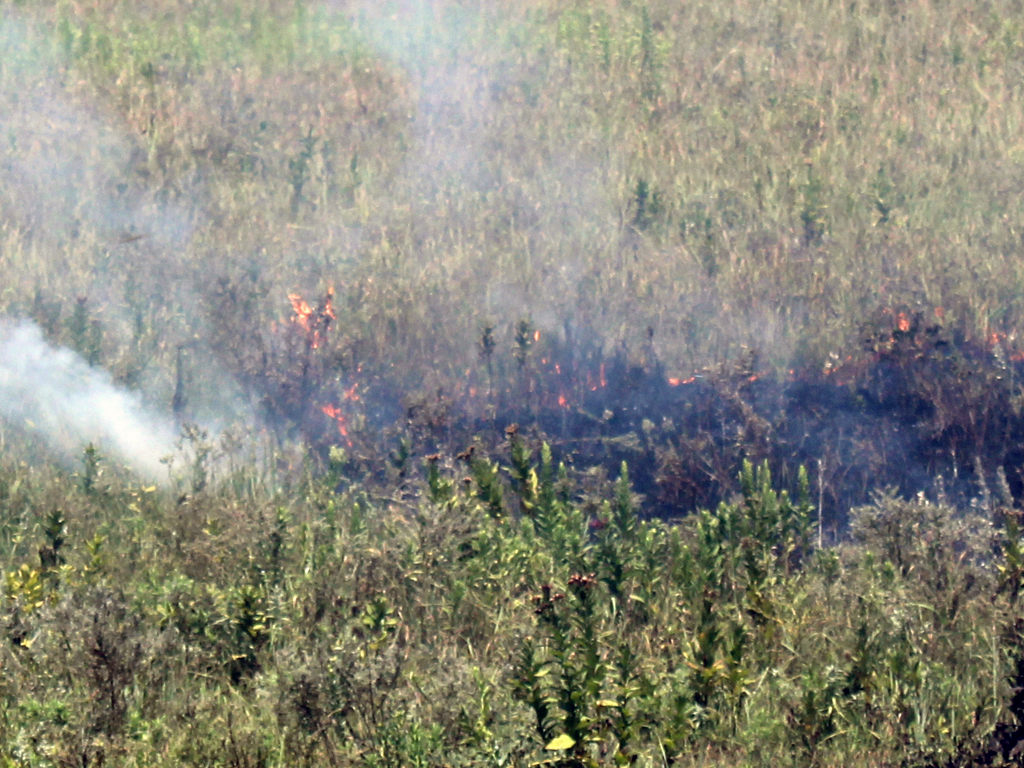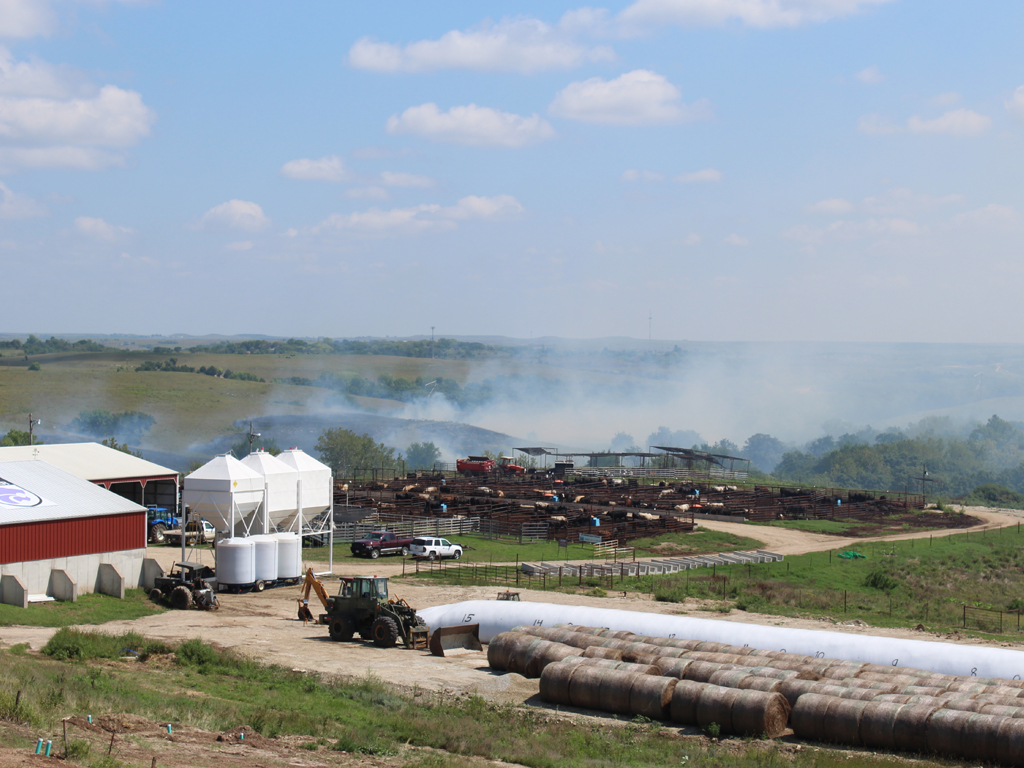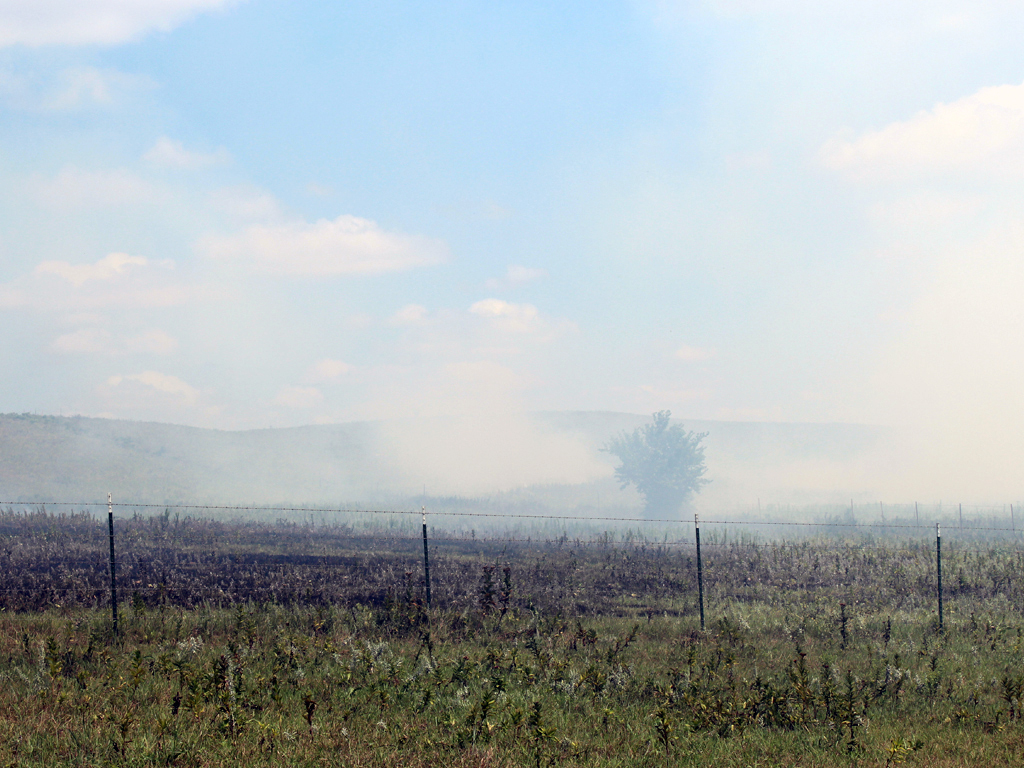
Summer prescribed pasture fires move slower, and leave more post-burn residue; however, summer burning has proven to provide better weed control, especially with sericea lespedeza. | Download this photo.
Summer pasture burning is underway
K-State researcher says conditions are ripe for this new approach
August 30, 2018
MANHATTAN, Kan. — Producers and land managers that canceled their prescribed pasture burning earlier this year could try burning now, especially if recent rains have moistened their land.
KC Olson, a professor of range beef cattle nutrition and management at Kansas State University, has been researching the net effects of different annual pasture burning schedules since 2014. Earlier this month, he helped coordinate a controlled burn at K-State’s Beef Stocker Unit, on the western edge of Manhattan.
“The day went exceptionally well,” Olson said. “I was a little apprehensive because many of the members of our crew were inexperienced with prescribed burning, but we were able to come up with a good burn plan and execute it safely.”
Late summer prescribed burning is something that Olson has been researching for a few years, and will continue researching into the next decade. Summer burning offers better control over sericea lespedeza, the cattle rancher’s arch nemesis among perennial weeds. It’s also easier on the environment and the people who live in it. Smoke is less concentrated, and the fire takes out a lot of the weeds and other pollen that brings allergy sufferers to tears.
Because of the drought conditions that shredded the burn plans of many producers this past spring, Olson hopes that at least a few land owners and pasture managers will light things up now. The Beef Stocker Unit burn, and an upcoming demonstration burn, are subtle nods of encouragement to give summer burning a try.

Summer pasture burning at the Kansas State University Beef Stocker Unit. | Download this photo.
Here’s how summer burning differs from spring burning:
- More fuel for the fire – Because summer fires have to chew through so much green growth, you’ll need more fuel for the drip torches. “I would estimate that on the 300 acres that we burned at the Stocker Unit, we used about a tenth of a gallon of accelerant per acre – we went through about 30 gallons of torch fuel,” Olson said. “In the spring, for that same area of land, it might have taken as little as 10 gallons of torch fuel.”
- Slower pace – Summer fires move a lot slower, so they’re generally a bit safer than spring fires. It’s possible to walk with them, but because you’re working in hotter ambient temperatures, it’s best to walk a little less. “All of our people were in vehicles,” Olson recalled, “so that we weren't wearing anybody out. We also used a lot of accelerant and a lot of torch fuel in just making sure that our fire lines were continuous.”
- Gettin’ Steamy – Green plant material contains water, and fire quickly turns that water to steam. “The smoke cloud looks dense, more intimidating, but that’s because of all the steam,” Olson said. For the people working the fire, as well as neighbors in the immediate area, the experience is less irritating.

The smoke given off by summer prescribed burning is white due to a high concentration of steam. Green plant material has a higher water content, the slow-moving fire instantly turns these water droplets into steam. | Download this photo.
While there are differences, Olson said many things remain the same:
- Helping hands – Even though a summer fire usually moves slower, you still want plenty of help, just as you would in the spring. Fire is fire, and unchecked, it’s still destructive. An experienced crew is best, but Olson finds summer fires to be great training opportunities. “Optimal fire conditions are best when initiating inexperienced people into prescribed burning,” Olson said. “Summertime fires are never particularly difficult to control and I think we were blessed that our people were able to get a full day of experience under conditions that were so good.”
- Conditions and seasons change, but laws stay the same – Before lighting a summer fire, you’ll still need a burn permit from your county government, and you’ll still need to advise all emergency personnel when you start the burn and when you’re done for the day. Lastly, stay alert to local media in case a burn ban is announced. “The local emergency management dispatchers will alert you if a burn ban has been instituted,” Olson cautioned, “but burn bans can also be removed as quickly as they are announced. You can be under burn ban conditions for a month and have a weekend of decent rainfall and then the burn ban goes away.”
The next few weeks may offer good opportunities for a prescribed burn, if you missed your chance back in April. Olson summarized the advantages to both land owners, and the state as a whole.
“Number one, the fire is simpler to manage; number two, it gets smoke out of the month of April and into a time when it's less concentrated in the atmosphere, which helps us be a better neighbor; number three, we can get excellent control of would be invaders like roughleaf dogwood, smooth sumac, and eastern red cedar; and number four, we get remarkable stimulation of our native legumes and nectar bearing wildflowers without any detrimental effect on the major tall grass species.”
“And then the last thing,” Olson said, “the one thing that I am most enthusiastic about – we get incredible control of sericea lespedeza with a fire lit in the August to September timeframe.”
It takes discipline to wait a few days for the best conditions to develop – for the wind speed and direction to take the smoke away from populated areas, for the soil and moisture conditions to be just right, but Olson said the payoff can be worth it.
“It was frustrating for us to wait for those conditions out at the Stocker Unit, but it was actually very simple to execute the burn once those conditions presented themselves,” he said.

